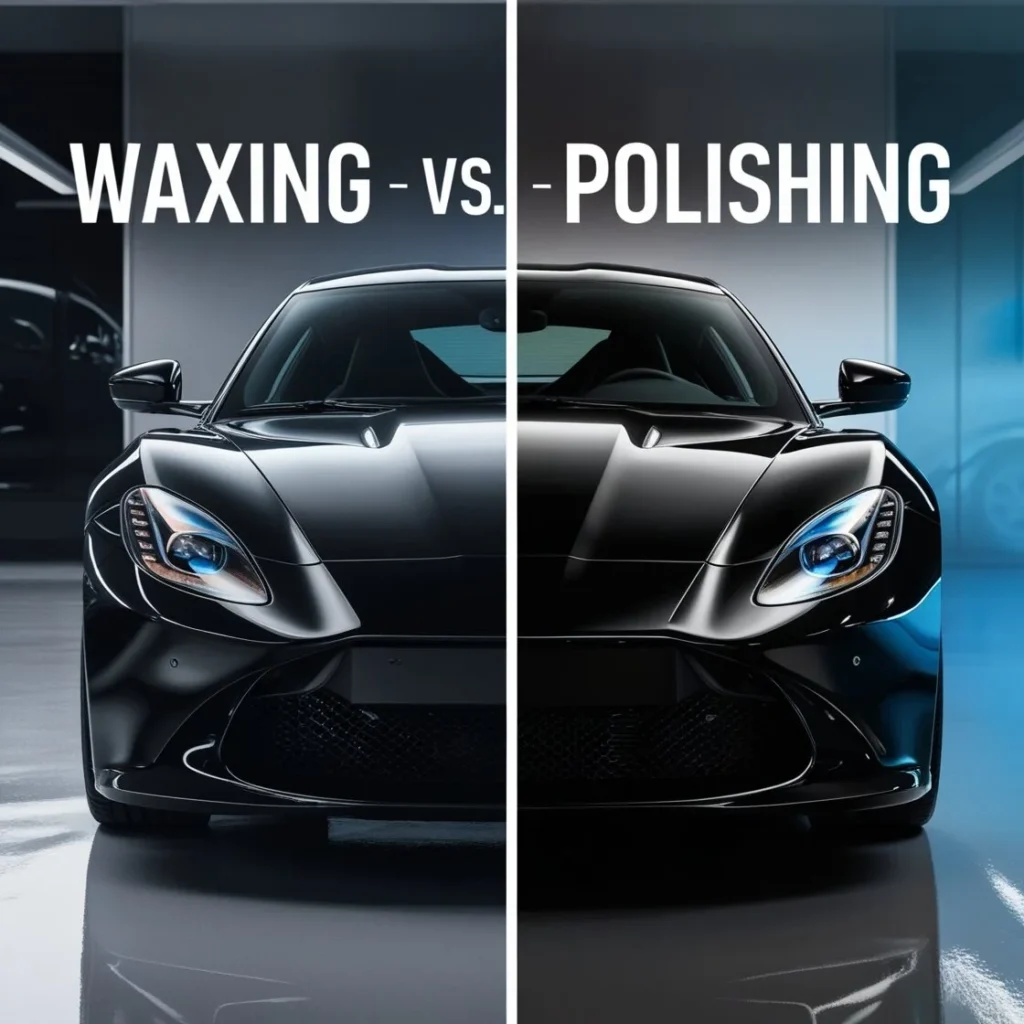Car Wax vs Polishing: What’s Better
When it comes to maintaining the appearance of your vehicle, two terms often come up: car wax vs polishing. While both processes contribute to the aesthetic and protective quality of your car’s paint, they serve different purposes and yield varying results. Understanding the distinctions between car wax and polishing is crucial for any car owner looking to maintain their vehicle’s value and appearance. In this article, we’ll delve into the differences, benefits, and proper techniques for both waxing and polishing.

Index
The Purpose of Car Wax vs Polishing
To fully appreciate the differences between waxing and polishing, it’s essential to first understand what each process entails. Car wax is primarily a protective layer applied to the paint surface. Its main purpose is to shield the paint from environmental contaminants such as UV rays, dirt, bird droppings, and tree sap. Wax also enhances the gloss and shine of the vehicle, providing a sleek finish that many car owners desire.
On the other hand, polishing is a corrective process designed to remove imperfections from the paint surface. This can include scratches, swirl marks, and oxidation. Polishing works by using abrasive compounds to smooth out the surface of the paint, restoring its clarity and depth. While both waxing and polishing are integral to car care, their functions are distinct and should not be confused.
Understanding the Components of Car Wax vs Polishing
Car wax and polishing compounds are made from different materials and designed for specific purposes.
Car wax is generally composed of natural or synthetic waxes. Natural carnauba wax is known for its excellent shine and depth of color. It creates a hydrophobic barrier that repels water and protects the paint from UV damage. Synthetic waxes, on the other hand, often include polymers that provide longer-lasting protection and durability. These synthetic options can also offer enhanced resistance to environmental factors, such as acid rain and pollution, which can significantly deteriorate paint quality over time.
Polishing compounds contain varying degrees of abrasiveness. These compounds are designed to break down and remove imperfections in the paint. They often contain fillers that can temporarily hide scratches and blemishes. The abrasiveness of the polish can range from very fine to coarse, depending on the severity of the imperfections being addressed. For example, a heavy cut polish is suitable for deep scratches, while a finer polish is better for minor imperfections and enhancing shine.
When to Wax vs Polishing to Polish
Knowing when to wax and when to polish your car is key to effective vehicle maintenance.
Typically, you should wax your car every three to six months, depending on the environmental conditions and the type of wax used. Factors such as exposure to sunlight, rain, and road salts can accelerate the degradation of wax. If you notice that the wax has degraded or the shine has diminished, it’s time to reapply. Regular waxing not only enhances the appearance but also adds a protective layer against harmful elements. This is particularly important in areas with harsh climates or high levels of pollution, where the paint can suffer significantly without proper protection.
Polishing, however, is generally not required as frequently as waxing. You might need to polish your car when you notice significant paint imperfections, such as deep scratches or a dull, faded appearance. If your car’s paint has lost its gloss and clarity, polishing is the right solution. It’s also advisable to polish your car before applying wax to ensure a smooth and flawless finish.
Many enthusiasts recommend polishing once or twice a year, but this can vary based on the vehicle’s usage and environmental exposure. Frequent polishing can lead to thinning of the clear coat, so it’s important to assess the condition of your paint before deciding on a polishing schedule.
The Process of Wax vs Polishing
The application processes for waxing and polishing are quite different.
When waxing your car, the first step is to ensure the surface is clean and dry. This can be done by washing the car thoroughly and drying it with a microfiber towel to prevent any scratches during the waxing process. Using an applicator pad, apply the wax in small, circular motions, covering one section of the car at a time. Allow the wax to haze, which usually takes a few minutes, before buffing it off with a clean microfiber towel. This method reveals a shiny, protected surface that enhances the overall appearance of the vehicle.
Polishing requires more preparation. First, wash and dry the car to remove any dirt or debris. It’s advisable to do this in a shaded area to prevent water spots from forming. Next, choose the right polishing compound based on the severity of the imperfections. Using a dual-action polisher or a rotary buffer, apply the polish to the paint surface in overlapping sections. This method ensures an even application and thorough correction of imperfections. Depending on the polish used, you may need to adjust the speed of your polisher; generally, a lower speed is better for beginners, while experienced users may opt for higher speeds to achieve quicker results.
Once the desired results are achieved, wipe away any residue with a microfiber towel. It’s crucial to work systematically and avoid polishing too much in one area, as this can lead to uneven results or further damage to the clear coat.
Benefits of Wax vs Polishing
Both waxing and polishing offer distinct benefits that contribute to the overall maintenance of your vehicle.
The primary benefit of waxing is the protection it provides. By creating a barrier against UV rays and environmental contaminants, waxing helps preserve the integrity of your car’s paint. Additionally, a fresh coat of wax enhances the overall appearance, giving your vehicle a glossy finish. This glossy layer also helps repel dirt and makes washing your car easier, as contaminants are less likely to adhere to a well-waxed surface.
Polishing, on the other hand, is all about restoring and enhancing the paint’s condition. It removes imperfections, resulting in a smooth, reflective surface. This corrective process can rejuvenate a car’s exterior, making it look as good as new. Polishing can also prepare the paint for waxing, ensuring better adhesion and longer-lasting protection. Furthermore, polishing can increase the depth of color in your paint, making the vehicle appear more vibrant.
The Importance of Regular Maintenance
Incorporating both wax vs polishing into your car maintenance routine is crucial for preserving your vehicle’s appearance and value. Regularly waxing your car protects it from wear and tear, while occasional polishing removes imperfections that can accumulate over time.
It’s essential to assess the condition of your car’s paint regularly. Look for signs of fading, scratches, or dullness. If your car shows these signs, it may be time for a polishing session. Additionally, washing your car regularly is fundamental to maintaining both the wax and polish. Dirt and grime can accumulate, leading to scratches and other forms of damage if not cleaned promptly.
To maximize the effectiveness of your waxing and polishing routine, consider investing in high-quality products. Not all waxes and polishes are created equal; some contain better ingredients and offer superior results. Researching and choosing products that suit your specific vehicle type and color can make a significant difference in the outcome.
The Environmental Impact of Wax vs Polishing
In recent years, there has been a growing awareness of the environmental impact of car care products. Many traditional waxes and polishes contain chemicals that can be harmful to the environment. This has led to the development of eco-friendly alternatives that offer similar benefits without the negative impact.
When choosing waxes and polishes, consider looking for biodegradable options or products with minimal harmful chemicals. Many brands now offer formulations that are not only effective but also safe for the environment. These products can provide excellent results while minimizing your ecological footprint.
Hand Polish: A Detailed Approach for DIY Enthusiasts
Hand polishing is a technique that allows car owners to enhance their vehicle’s appearance without the need for complex equipment like electric buffers. This method is ideal for minor touch-ups and maintaining the shine of your paintwork between professional polishing sessions. With hand polish, you have more control over pressure and speed, which minimizes the risk of damaging the paint or clear coat.
To begin, ensure your car is thoroughly cleaned and dried. Apply a small amount of polish to a microfiber or foam applicator pad, and work it into the paint surface using gentle, circular motions. Focus on one small area at a time to achieve even results. This process may take longer than machine polishing, but it’s perfect for those who prefer a more hands-on approach. After polishing, remove any residue with a clean microfiber towel, and follow up with a coat of wax for added protection and shine.
Hand polish is a great option for car enthusiasts who want to maintain their vehicle’s appearance with a bit of personal care, ensuring a glossy, well-kept look without the need for professional tools.
Conclusion: Choosing the Right Approach for Your Car Wax vs Polishing
In summary, while both waxing and polishing are integral to car maintenance, they serve different purposes. Waxing provides a protective layer that enhances shine, while the polish process corrects imperfections and restores clarity. Understanding the differences between these two processes will empower you to make informed decisions about your vehicle’s care.
To maintain your car’s appearance effectively, establish a regular schedule for washing, waxing, and polishing. By doing so, you’ll ensure that your vehicle remains in top condition for years to come. Whether you’re a car enthusiast or simply want to keep your vehicle looking its best, mastering the art of waxing and polishing is a valuable skill that pays off in the long run.
By incorporating these practices into your routine, you not only enhance your vehicle’s aesthetics but also contribute to its longevity. Regular maintenance can prevent costly repairs down the road, ensuring that your investment in your car is well-protected.
